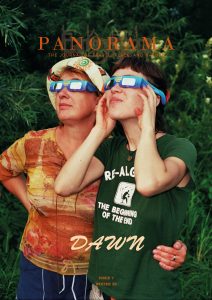The train was approaching. The adrenaline kicked into my system. We were joining the commuters in their daily crossing of Thane Creek from Old Mumbai to Navi Mumbai. It was day eight of our 14-day sibling backpacking adventure through our ancestral country.
Ranga Rao Uncle, an old friend of our Hyderabadi family, lived in Navi Mumbai with his wife and worked in the City Center in Mumbai. We were to stay with him in the perceived safety of modern Navi – or New – Mumbai, a city designed in the 1960s and messaged as a more spacious “counter magnet” to address the over-population of Mumbai. The concept was very familiar to our Californian suburban upbringing; hyper-curated smaller cities for families to expand within a short distance to world-renowned yet gritty cities.
“No time to dilly dally. Ravi, take your sister’s hand to lead her. Make sure she gets on the train.” Uncle had not looked directly at me since his rickshaw picked us up from where the Pune bus had dropped us–a ditch along a busy city street below a highway on-ramp. It appeared that Uncle wouldn’t look into my eyes, even when referring to me.
Ravi’s eyes widened. He darted a look down at me from eyes half a foot above my head. I smiled blandly. This particular part of our adventure was in my wheelhouse. Since leaving the Bay Area for a liberal arts college in Oregon eight years prior, I had explored our home country reliant on public transportation in Portland, then Chicago, and now Baltimore with easy access to all major East Coast cities. Trains had become my favorite form of transportation and based on years spent with Bollywood and ZeeTV, Mumbai offered the epitome of train travel excitement.
The front of the train began to whoosh past us, simultaneously onboarding and off-boarding. Ravi and I prepared our bodies to jump. My grin grew wide. My limbs shook with anticipation, while my eyes locked onto the side of the train sussing out potential openings.
I grabbed a firm hold onto my brother’s left arm with my right arm, hooked my left hand securely on the train car’s door handle, and launched us onto the moving machine. After looking down to ensure our sneakers were firmly on the train car, I snapped my head up and swam us forward toward the first nook I could find.
We dove for the coveted spot with muscle and might–a front-facing corner of a doorway beside a map of stops. My back now firmly against the closed train door, I added a slight bend to my knees and extended my round hips out to ensure a strong stance. Confident that we were both safe, I scanned the train car’s signage for anything English.
A sign posted above the doorway to the next car read: This Way to Women Only Car.
My mind – the mind of a U.S.-born South Indian-American 26-year-old queer woman on her first trip to India as an adult – did not know how to compute this information.
Rolling my eyes, I mouthed “Whoops!” to Ravi. Following my eyes, he read the sign, his eyes widening. We looked around to confirm that, in fact, I was the only visible woman in this car. I became aware of the car filled to the brim with commuting Uncles with stern eyebrows pointed in my direction. We began to giggle, which for me evolved into my notorious American-ly deep loud guffaw. The Uncle-brows monstrously transformed into full-on silent upset.
My face stretched and contorted with rubbery awkwardness. Ravi inched slowly towards me like a panther, smiling. “Whoops, indeed,” he whispered. We had a secret language, my brother and I. Developed over years of awkward brown kid bonding through racialized isolation, generational misplacement, parental tensions, and immigrant fears. His jovial attitude provided me with a sense of security at that moment. His smile told me: this will be a story we will tell for ages and it will be hilarious.
Blushing through my deep brown skin, I assumed I was being offered two options by the Navi Mumbai commuter train: direct myself one car over to sit with the other women-folk or continue to take up space. A warm river of pride began to flow through my veins. I was not going to give in to gender segregation. I was not going to abandon my brother in this new place. I planted my feet deeper into the coveted corner.
Once we travelled over the large Thane Creek via the 41-mile Mumbai Suburban Railway bridge, we were in a new yet surprisingly familiar world. The train came to a complete stop and the passengers filed off in a practiced, respectful flow. Recent memories of the commuter Caltrain flashed in front of me. Indian businessmen follow their end-of-workday routines, whether leaving the flashy skyscrapers of San Francisco for Sunnyvale’s cookie-cutter houses, or colourful grand Mumbai for monotone Navi Mumbai.
Immediately upon setting foot off the train, I curiously searched the departing train for a glimpse of this segregated space for my gender kin. A flow of bright colours and airy fabrics rolled down from the train a short distance away. Women with gentle smiles and children in tow. A painting on a passenger car of a woman with a red bindi and blue-trimmed pale pink saree draping her head indicates the space designated for travelling women. I let out an audible sigh. Ranga Rao Uncle yelled “chello” and nodded his head towards the parking lot. It was a gesture Ravi and I had become accustomed to from our elders since childhood; a command indicating that we should follow him quickly.
If there were consequences to my sense of entitlement on the Navi Mumbai commuter train, they remain a mystery. Over the years, the Navi Mumbai train story became a hilarious anecdote I told when swapping travel stories with friends. A tale of my rebellion against tradition and cultural sexism; of how grateful I was for having been born and raised in the United States. In my retelling, I became more brash and bold, defiant of expectations put upon me. In treating my experience on the Mumbai commuter train as an anecdote with no explicit cultural context outside of my own assumptions, I was not yet aware that the story was not finished.
A decade later I finally learned the history of Mumbai’s women-only train car. With much gratitude to many Indian women journalists and bloggers, I came to learn that these cars were created in reaction to gender-based violence and harassment on public transportation. Policy-wise, offering an option to women to travel in a women-only car intended to encourage a sense of safety and security while in this public space.
On 5 May 1992, the Mumbai-based Western Railway opened the world’s first women-only train–an entire train route that ran twice a day across Mumbai’s metropolitan suburbs. This train ran infrequently, but became quite popular in the 1990s and 2000s among the increasing number of women entering the labour force and needing to commute into the city. In 2010, Mumbai’s general trains started designating women-only cars attached to other cars for the “general population” to use. In subsequent years, other major Indian cities such as Kolkata, Chennai, and Delhi have established women-only cars on their commuter trains and subways. These spaces designated for women also allow accompanied children of any gender up to age 16.
Women-only trains and passenger cars were set up as a policy response to reports from women survivors. Between 2004 and 2009, Mumbai’s division of the Western and Central Railway recorded 1,640 cases of crimes against women, including robbery, assault, harassment, and sexual violence. As anti-violence advocates across the world argue, it can be assumed that a significantly higher number of cases go unreported. Enforcement of this policy differs across regions, trains, and routes. However, if law enforcement identifies men using the women-only car, they can receive a civil penalty such as a fine or warning. Women have shared that often it is up to them to enforce the policy, either by approaching men directly, asking them to leave, or reporting them to posted guards on trains and stations.
In processing this information my brain has split into many hyphenated places. I’m navigating my training as a policy analyst who questions the fundamentals of this policy solution, my value in 1970s feminist thought teaching me that rape culture cannot be swept aside, my experience as a tired woman commuter who just wants to chill unbothered as I train home. As Ankita Rao argues in her 2014 Quartz opinion piece: “the real solution, I believe, lies in a shift in mindset, fueled by the public visibility of women in every space—not a designated corner—to create actual safety rather than the illusion of a comfort zone.” Her argument is solid and true, rooted in the value of deep cultural change. It is what I felt in that instant as I stood, a woman like no other, on that train full of men questioning my existence among them.
To be publicly visible as a woman of colour – whether on a train in Mumbai or a grocery store in Portland, Oregon – is a political act that I know well. This knowledge fueled my sense of pride as I decided to remain in that passenger car with my brother. As a student of critical race theory, I understand that oppression is systemic, and embedded in the fabric of our institutions and cultures. The trauma of racial segregation and invisibilization within United States history became an essential factor in my mind as I read that “women-only car” sign. My familiarity with that American trauma had me assuming this car was evidence of similar trauma in India.
Do these women-only cars serve as “pockets of freedom?” Rao argues strongly that these women-only cars do not offer access to freedom but instead they force women to work around the patriarchy’s stronghold. While I respect her argument, I believe that freedom is relative and life can be many acts–or momentary pockets–that keep us moving towards freedom and liberation. Working towards freedom is a life-long, generations-long journey. It requires vulnerable decolonization practices and graceful rebuilding.
What I’ve had to contend with most in my search for moments of freedom is a dilemma of being a second-generation immigrant and being a woman. Looking back a decade later at this adventure, my wiser eyes see that I had been comparing women’s access to freedom of space all across my ancestral home of India. In the houses of my family. In the houses of their gracious friends. On bustling public streets. Restaurants. Hotels. The Taj Mahal. Everywhere, I was searching for women, myself, and the spaces I would be taking up. Spaces in a universe wherein I was raised in India as all others in my family at that point–except my brother and I–had been raised. I was looking for evidence of the declaration made to me by white teachers and friends throughout my life: “wow, you are so fortunate that your parents moved to America before you were born because being a woman in India must be so difficult.”
I had been indoctrinated into the thought that my femme Brown body is more able to safely take up space in the United States. That here in my home country, I am more able to feel free and liberated. In reality, much of my life in this country has been dedicated to seeking out and curating safer spaces just for women, queer, and/or people of colour who share my value of a place to breathe and loosen. A place to feel free, if ever so fleeting, because freedom is relative.
For many passengers, the sense of safety and security on the women-only train car may feel sweetly freeing. As Rhitu Chatterjee shared in her 2016 NPR opinion piece, “the body language of women in this car feels different. They look carefree… smiling and tilting their heads in ways they wouldn’t dare to outside the women’s car.” It is hard to imagine how I would have experienced the women-only passenger car of that Mumbai train in January 2012. Likely, I would have felt very uncomfortable being separated from my brother in another car. Or maybe I would have observed myself reflected in the women around me, taking in the pocket of freedom. Next time I make the visit to my ancestral home of India, I will jump and swim forward toward the women-only car to potentially loosen my travel-weary body.
Endnotes
[i] Chatterjee, Rhitu. NPR. (April 4, 2016). Why I Love Riding On The Women-Only Car On Delhi’s Metro.
[ii] Rao, Ankita. Quartz. (November 23, 2014). Why the Delhi Metro needs to get rid of the ladies compartment.
[iii] Verma, Kaplana. The Indian Express. (May 24, 2009). Women at receiving end in trains.











